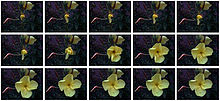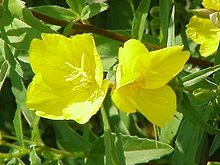- Oenothera
-
"Evening Primrose" redirects here. For the musical, see Evening Primrose (musical).
Oenothera 
Oenothera glazioviana Scientific classification Kingdom: Plantae Division: Magnoliophyta (unranked): Eudicots Order: Myrtales Family: Onagraceae Subfamily: Onagroideae Tribe: Onagreae Genus: Oenothera
L.[1]Species 145 species (188 taxa) in 18 sections, including:
An evening-primrose cultivated in England Flowers of an Oenothera usually open within about a minute (real time, no time-lapse).
Flowers of an Oenothera usually open within about a minute (real time, no time-lapse).
Oenothera is a Genus of about 125 species of annual, biennial and perennial herbaceous flowering plants, native to North and South America. It is the type genus of the family Onagraceae, the Evening Primrose Family. Common names include evening-primrose, suncups, and sundrops.
The species vary in size from small alpine plants 10 cm tall (e.g. O. acaulis from Chile), to vigorous lowland species growing to 3 m (e.g. O. stubbei from Mexico). The leaves form a basal rosette at ground level and spiral up to the flowering stems; the leaves are dentate or deeply lobed (pinnatifid). The flowers of many species open within less than a minute in the evening, hence the name "evening-primrose", and are yellow in most species but white, purple, pink or red in a few. Most native desert species are white. The fragrant tufted evening-primrose Oenothera caespitosa, a Southwestern species, first blooms white but turns pink or light magenta.[3]
One of the most distinctive features of the flower is the stigma with four branches, forming an X shape.[4] Pollination is by Lepidoptera (moths) and bees; like many members of the Onagraceae, however, the pollen grains are loosely held together by viscin threads (see photo below), meaning that only bees that are morphologically specialized to gather this pollen can effectively pollinate the flowers (it cannot be held effectively in a typical bee scopa). Furthermore, the flowers are open at a time when most bee species are inactive, so the bees which visit Oenothera are also compelled to be vespertine temporal specialists. The seeds ripen from late summer to fall.
Oenothera species are used as food plants by the larvae of some Lepidoptera species including Schinia felicitata and Schinia florida, both of which feed exclusively on the genus, the former exclusively on O. deltoides.
In the wild, evening-primrose acts as a primary colonizer, quickly appearing wherever a patch of bare ground may be found. It tends to germinate in disturbed soil, meaning that it tends to be found in poorer environments such as dunes, roadsides, railway embankments and wasteland. It often occurs as a casual, eventually being out-competed by other species.
Contents
Origin
The genus Oenothera may have originated in Mexico and Central America [5][6] from which it spread into North and South America and, with the advent of international travel, species are now found in most temperate regions. During the Pleistocene era a succession of ice ages swept down across North America, with intervening warm periods. This was repeated for four ice ages, with four separate waves of colonization, each hybridizing with the remnants of the previous waves [6][7] This generated a present-day group of species forming the subsection Euoenothera which is very rich in genetic diversity, spread right across the North American continent. These species are morphologically diverse and are largely interfertile and so the species boundaries have been a source of dispute amongst taxonomists.[5][8]
This pattern of repeated colonizations resulted in a unique genetic conformation in the Euoenotherae whereby the chromosomes at meiosis can form into circles of varying size, rather than complete chromosome pairing as in common meiosis. This is the result of several reciprocal translocations between chromosomes so that the pairing occurs only at the tips. This phenomenon has some apparently non-Mendelian genetic consequences. By combining this mode of chromosome segregation with a system of balanced-lethal genes, genetic recombination is prevented and the plants enjoy the vigour of heterosis.[9] This resulted in the evolution of a large number of sympatric races over North America, east of the Rocky Mountains. Analysis of the cytology of these races and of artificial hybrids between them allowed a detailed understanding of the genetic and geographic evolution of the Euoenotherae. This whole subject was a major area of genetic research during the first half of the 20th century.[7][10]
Taxonomy
Evening-primrose was originally assigned to the genus Onagra, which gave the family Onagraceae its name. Onagra (meaning "(food of) onager") was first used in botany in 1587, and in English in Philip Miller's 1754 Gardeners Dictionary: Abridged. Its modern name Oenothera was published by Carolus Linnaeus in his Systema Naturae. Its etymology is uncertain but is believed to be derived from the Greek words ονος θηρας (onos theras), meaning "donkey catcher," or οινος θηρας (oinos theras), meaning "wine seeker."[11] In addition, oenothera means "a plant whose juices may cause sleep" in Latin.[12]
In 1905, while studying the genetics of Oenothera lamarckiana, Hugo de Vries discovered a variant with a chromosome number of 2N = 28 compared with 2n = 14 for O. lamarckiana. DeVries was unable to breed this variant with O. lamarckiana. He named the variant Oenothera gigas.[13]
Uses
Young roots can be eaten like a vegetable (with a peppery flavor), or the shoots can be eaten as a salad. Poultices containing O. biennis were at one time used to ease bruises and speed wound healing. One of the common names for Oenothera, "Kings cureall", reflects the wide range of healing powers ascribed to this plant, although it should be noted that its efficacy for these purposes has not been demonstrated in clinical trials.
The mature seeds contain approximately 7-10% gamma-linolenic acid, a fatty acid. The oil also contains around 70% linoleic acid.[14] The O. biennis seed oil is used to reduce the pains of premenstrual stress syndrome. Gamma-linolenic acid also shows promise against breast cancer.[15] Some side effects of using evening primrose oil are itching, sore throat and severe or extreme gassiness.[citation needed]
Cultivation
A number of perennial members of the genus are commonly cultivated and used in Southwestern U.S. landscapes. The more popular species include Oenothera caespitosa, the tufted evening primrose, Oenothera berlanderii, the Mexican evening primrose, and Oenothera stubbei the Saltillo primrose.[16]
Annual evening-primroses are very popular ornamental plants in gardens. For best growth, the seeds can be sown in situ. In temperate climates, planting should be from late spring to early summer. Some species grow successfully in fertile soils if competing species are kept at bay. Some evening-primrose species can be planted in any ordinary, dry, well-drained garden soil (preferably sandy loam) in an open site that is sunny to partly shady. Many are fairly drought-resistant.
The first plants to arrive in Europe reached Padua from Virginia in 1614 and were described by the English botanist John Goodyer in 1621. Some species are now also naturalized in parts of Europe and Asia, and can be grown as far north as 65° N in Finland. The UK National Council for the Conservation of Plants and Gardens, based at Wisley, maintains an Oenothera collection as part of its National Collections scheme.
References
- ^ "Genus: Oenothera L". Germplasm Resources Information Network. United States Department of Agriculture. 2004-03-22. http://www.ars-grin.gov/cgi-bin/npgs/html/genus.pl?8398. Retrieved 2010-10-28.
- ^ GRIN. "Species in GRIN for genus Oenothera". Taxonomy for Plants. National Germplasm Resources Laboratory, Beltsville, Maryland: USDA, ARS, National Genetic Resources Program. http://www.ars-grin.gov/cgi-bin/npgs/html/splist.pl?8398. Retrieved July 11, 2010.
NOTE: The GRIN list does not include Oenothera deltoides, nor O. caespitosa; the latter is because it lists it as O. cespitosa, as does IPNI (for which, see here). - ^ Calflora database
- ^ Roger Tory Peterson and Margaret McKenny (1968). A field guide to wildflowers of northeastern and north-central North America. Boston: Houghton Mifflin. ISBN 0-395-91172-9.
- ^ a b Peter H. Raven; Werner Dietrich, Wilfried Stubbe (1979). "An outline of the systematics of Oenothera subsect. Euoenothera (Onagraceae)". Systematic Botany (Systematic Botany, Vol. 4, No. 3) 4 (3): 242–252. doi:10.2307/2418422. JSTOR 2418422.
- ^ a b Werner Dietrich; Warren L. Wagner, Peter H. Raven (1997). Systematics of Oenothera section Oenothera subsection Oenothera (Onagraceae). Laramie: The American Society of Plant Taxonomists. ISBN 0-912861-50-9.
- ^ a b Ralph E. Cleland (1972). Oenothera - Cytogenetics and evolution. Boston: Academic Press. ISBN 0-12-176450-8.
- ^ Krzysztof Rostanski (1985). "The classification of subsection Oenothera (section Oenothera, Oenothera L., Onagraceae)". Feddes Report 96 (1–2): 3–14.
- ^ Uwe Rauwolf; Hieronim Golczyk, Jörg Meurer, Reinhold G. Herrmann, Stephan Greiner (2008). "Molecular marker systems for Oenothera genetics". Genetics 180 (3): 1289–1306. doi:10.1534/genetics.108.091249. PMC 2581935. PMID 18791241. http://www.pubmedcentral.nih.gov/articlerender.fcgi?tool=pmcentrez&artid=2581935.
- ^ Cornelia Harte (1994). Oenothera - Contributions of a plant to biology. Berlin: Springer-Verlag. ISBN 3-540-53114-9.
- ^ Gledhill, D. (2008). The Names of Plants (4 ed.). Cambridge University Press. p. 278. ISBN 9780521866453. http://books.google.com/books?id=NJ6PyhVuecwC.
- ^ Quattrocchi, Umberto (2000). CRC World Dictionary of Plant Names. III: M-Q. CRC Press. p. 1860. ISBN 9780849326776. http://books.google.com/?id=kaN-hLL-3qEC.
- ^ "Observed Instances of Speciation". Joseph Boxhorn. 1995-09-01. http://www.talkorigins.org/faqs/faq-speciation.html.
- ^ National Non-Food Crops Centre."Evening Primrose", Retrieved on 2009-03-27
- ^ "Plant oil 'acts like cancer drug'". BBC News. 2005-11-02. http://news.bbc.co.uk/2/hi/health/4395826.stm. (describing work by Dr Javier Menendez and colleagues at Northwestern University and published in Journal of the National Cancer Institute).
- ^ Jones W. & Sacamano C. 2000. Landscape Plants for Dry Regions. Fisher Books. ISBN 1-55561-190-7
External links
 Media related to Oenothera at Wikimedia Commons
Media related to Oenothera at Wikimedia Commons  Data related to Oenothera at Wikispecies
Data related to Oenothera at Wikispecies- Classification of the Evening Primrose Family at the Smithsonian Institution
- Details from A Modern Herbal, by Mrs M Greives at Botanical.com
- Plants For A Future
- "The evening primrose" A poem by John Clare
- Oenothera Biennis
- Oenothera Drummondii
- Oenothera Fruticosa
- Oenothera Speciosa
Categories:- Night-blooming plants
- Flowers
- Medicinal plants
- Onagraceae
Wikimedia Foundation. 2010.
Look at other dictionaries:
Oenothera — ● Oenothera biennis ● Oenothera fruticosa ● Oenothera speciosa ● et al Oenothera es un género de aproximadamente 125 especies de hierbas anuales, bieniales y perennes . Es el género tipo de la familia Onagraceae. Se llamán erróneamente prímula,… … Enciclopedia Universal
Oenothēra — L. (Nachtkerze), Gattung der Önotherazeen, ein oder mehrjährige Kräuter mit einfachen, gezahnten, auch fiederspaltigen, rosettenförmig gestellten Wurzelblättern, abwechselnden Stengelblättern, schönen, großen, meist gelben, einzeln in den Achseln … Meyers Großes Konversations-Lexikon
Oenothera — Oenothēra L., Pflanzengattg. der Onagrazeen, Kräuter, fast sämtlich aus Amerika. O. biennis L. (Gartenrapunzel, Nachtkerze, Siebenschläfer [Abb. 1289]), aus Nordamerika, bei uns überall verwildert; ihre in der Kultur fleischig werdenden Wurzeln… … Kleines Konversations-Lexikon
Oenothera — Oenothera, Pflanzengattung aus der Familie der Onagrarieen; die bekannteste ist die gelbe Nachtkerze (O. biennis) aus Virginien stammend, blüht wild, besonders auf Schutthaufen und wird der eßbaren Wurzel wegen in den Gärten gebaut … Herders Conversations-Lexikon
Oenothera — Œnothère Pour les articles homonymes, voir Onagre … Wikipédia en Français
Oenothera — Nachtkerzen Gemeine Nachtkerze (Oenothera biennis), Illustration Systematik Klasse … Deutsch Wikipedia
Oenothera — Oenothera … Wikipedia Español
Oenothera — noun chiefly North American herbs with usually nocturnal flowers • Syn: ↑genus Oenothera • Hypernyms: ↑dicot genus, ↑magnoliopsid genus • Member Holonyms: ↑Onagraceae, ↑family Onagraceae, ↑ … Useful english dictionary
Oenothera — nakviša statusas T sritis vardynas apibrėžtis Nakvišinių (Onagraceae) šeimos augalų gentis (Oenothera). atitikmenys: lot. Oenothera angl. evening primrose; night willow herb vok. Nachtkerze rus. ослинник; энотера lenk. wiesiołek … Dekoratyvinių augalų vardynas
Oenothera — Oe|no|the|ra [øno...] die; , ...ren <über (n)lat. oenothera aus gr. oinothe̅ras »Blume mit Weingeruch der Wurzel« (zu oĩnos »Wein«)> Nachtkerze; krautige Pflanze mit größeren gelben Blüten (wild wachsend, aber auch als Gartenstaude) … Das große Fremdwörterbuch


